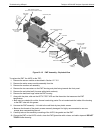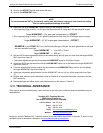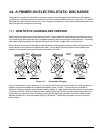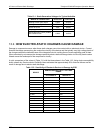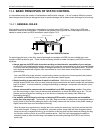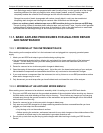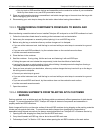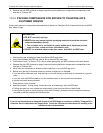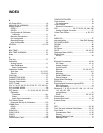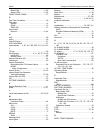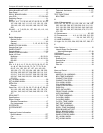
A Primer on Electro-Static Discharge Teledyne API M100E Analyzer Operation Manual
298
13.4. BASIC PRINCIPLES OF STATIC CONTROL
It is impossible to stop the creation of instantaneous static electric charges. It is not, however difficult to prevent
those charges from building to dangerous levels or prevent damage due to electro-static discharge from occurring.
13.4.1. GENERAL RULES
Only handle or work on all electronic assemblies at a properly set up ESD station. Setting up an ESD safe
workstation need not be complicated. A protective mat properly tied to ground and a wrist strap are all that is
needed to create a basic anti-ESD workstation (refer to figure 12-2).
Wrist Strap
Protective Mat
Ground Point
Figure 13-2: Basic Anti-ESD Work Station
For technicians that work in the field, special lightweight and portable anti-ESD kits are available from most
suppliers of ESD protection gear. These include everything needed to create a temporary anti-ESD work area
anywhere.
Always wear an Anti-ESD wrist strap when working on the electronic assemblies of your analyzer.
An anti-ESD wrist strap keeps the person wearing it at or near the same potential as other grounded objects
in the work area and allows static charges to dissipate before they can build to dangerous levels. Anti-ESD
wrist straps terminated with alligator clips are available for use in work areas where there is no available
grounded plug.
Also, anti-ESD wrist straps include a current limiting resistor (usually around one meg-ohm) that protects
you should you accidentally short yourself to the instrument’s power supply.
Simply touching a grounded piece of metal is insufficient. While this may temporarily bleed off static
charges present at the time, once you stop touching the grounded metal new static charges will immediately
begin to re-build. In some conditions, a charge large enough to damage a component can rebuild in just a
few seconds.
Always store sensitive components and assemblies in anti-ESD storage bags or bins: Even when
you are not working on them, store all devices and assemblies in a closed anti-Static bag or bin. This will
prevent induced charges from building up on the device or assembly and nearby static fields from
discharging through it.
Use metallic anti-ESD bags for storing and shipping ESD sensitive components and assemblies
rather than pink-poly bags. The famous, “pink-poly” bags are made of a plastic that is impregnated with a
liquid (similar to liquid laundry detergent) which very slowly sweats onto the surface of the plastic creating a
slightly conductive layer over the surface of the bag.
While this layer may equalizes any charges that occur across the whole bag, it does not prevent the build
up of static charges. If laying on a conductive, grounded surface, these bags will allow charges to bleed
away but the very charges that build up on the surface of the bag itself can be transferred through the bag
by induction onto the circuits of your ESD sensitive device. Also, the liquid impregnating the plastic is
eventually used up after which the bag is as useless for preventing damage from ESD as any ordinary
plastic bag.
04515F DCN6048



